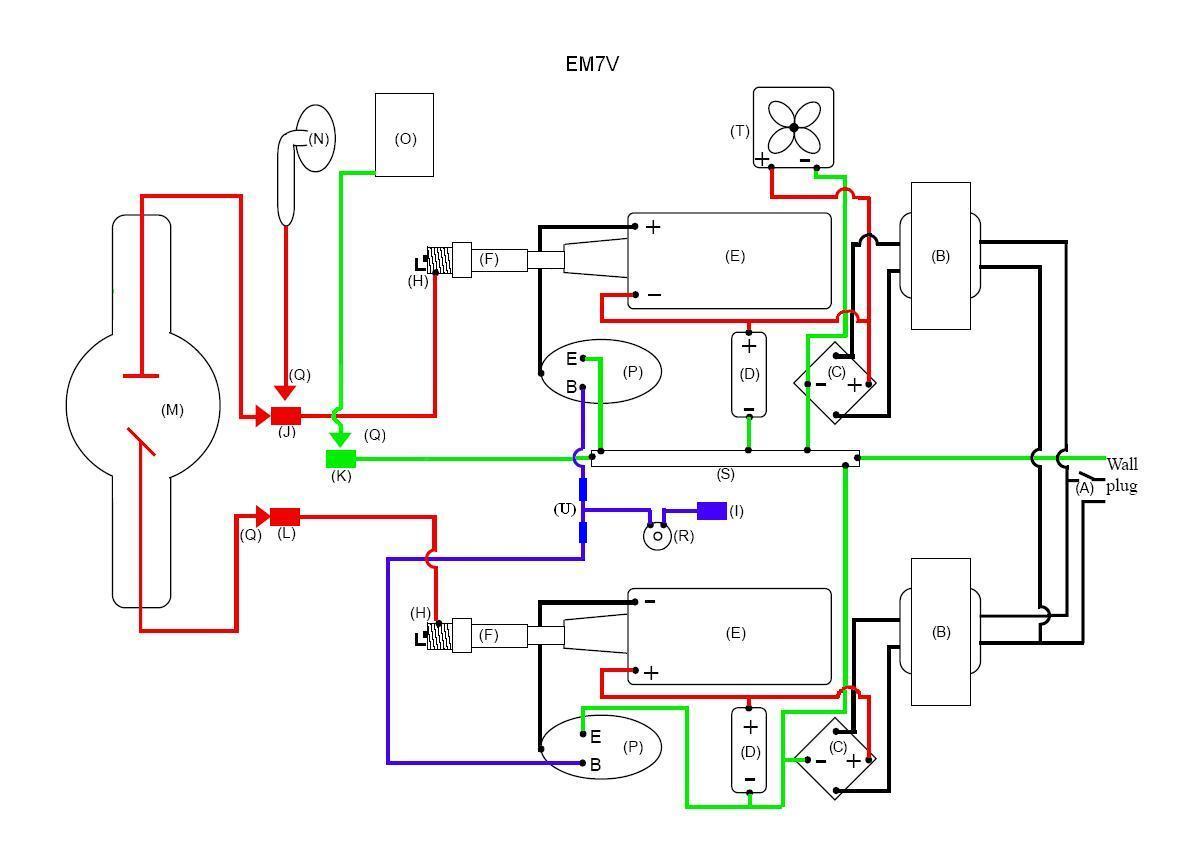CAUTION: Very high voltages are involved. Do not attempt construction unless you have adequate understanding of electronics.
I have modified Paul Chubbuck’s notes and diagram to include the latest EM7V technololgy. The EM7V uses coils wired in anti-parallel which increases both the magnetic and electrical fields. The unit can also be run with one of the bulb wires disconnected for even greater magnetic and electrical fields. This version of the EM7V leaves out the internal 555 timer circuit, the 6 associated potentiometers, the internal/external switch, the set/run switch, the frequency counter, and the pin jacks to plug in the frequency counter. Instead, it uses a programmable frequency source such at the F105.
The EM7V may also be used as a contact device. Just disconnect one phanotron wire and cap that wire with plastic tubing. Add a grounding contact pad that is plugged into the ground jack. Also illustrated is a violet ray bulb that can be used as a contact device in place of the Phanotron tube. An Enhancer bulb can also be used.
CAUTION: Using either the Phanotron, Enhancer, or the Violet Ray bulb as contact devices with a grounding pad may theoretically increase effectiveness by bringing the frequencies into direct contact with particular areas of the body, but there is also a risk of very unpleasant, high-voltage shock. VERY IMPORTANT precautions are ESSENTIAL to avoid this. First, the Phanotron and/or Violet Ray bulb must be mounted and insulated in such a way that the person handling the bulb will not inadvertantly be shocked by accidentally touching any contact points. Secondly, the following sequence should be followed to avoid shocks.
- Turn the unit off.
- Turn the illustrated 50 k Ohm potentiometer (R) to maximum resistance/low amplitude.
- Touch the bare feet or other bare skin to the grounding pad.
- Touch the bulb to another area of bare skin.
- Turn the unit on.
- Slowly turn up the amplitude on the potentiometer until a slight tingling is felt. This may need to be adjusted differently for different frequencies.
When dis-engaging, the reverse sequence should be used to avoid shocks. In other words, turn down the amplitude to minumum and shut the unit off before removing the bulb from skin contact.
Note: Study the em7v.jpg before ordering parts. In many cases, 2 or more of the parts listed are needed.
Parts illustrated in the drawing
(A) 110 V On/Off Switch (hardware store or Radio Shack)
(B) 120 V to 12 V Transformers — Marlin P. Jones (800-652-6733) has the 4 amp 12 volt (6-0-6) stock number 7840-TR. They also stock the 10 amp
12-0-12 stock number 7846-TR. The 10 amp model is much larger and heavier and requires a larger box.
(C) Bridge rectifier, 25 amp, 50 V Radio Shack part no. 276-1185 or Mouser part number 625GBPC25005 or 625GBPC2510.
(D) 4700µF 35V 20% Capacitor Radio Shack part no. 272-1022 or Mouser part number 140XAL35V4700.
(E) Shucks DR178 or NAPA Coil IC12SB. NOTE: One coil is wired backwards or anti-parallel. This greatly increases the output of the unit.
(F) Bosch Platinum plug 4214. Bend the prong in to provide a gap of .008 or so.
(H) Use heavily insulated copper stranded wire GTO-15 E133573A available at neon shops and 3730 GTO sleeving to slide over wire to increase insulating value. You can also use copper spark plug wire. Use this for all high voltage wire. To secure this wire to the spark plug, strip about 1-1/2 inch of insulation off and divide the strands into two. Twist these two groups of strands separately and wrap them around opposite sides of the threaded part of the spark plug. Twist the two strands together tightly on other side and solder. You’ll also need two 6 foot pieces of the wire to run outside the box to the phanotron tube.
(I) BNC jack Radio Shack no. 278-105 to plug in frequency generator. As a frequency source, the programmable F105 is recommended. See http://atelierrobin.tripod.com. You will also need a BNC to BNC cord to connect the F105 to your EM7V (Radio Shack part no. 278-964). Those preferring the 555 timer circuit may follow instructions at emem2. In that case, simply wire the output signal of that circuit into this diagram in place of this BNC jack.
If you want to be able to use both internal 555 frequencies and an external frequency source (we do), use this drawing to wire up the switches, BNC connector and tip jacks for the meter. The tip jacks are from http://www.mouser.com/, part numbers 105-0802-001 and 105-0803-001
(J) Banana jack carrying high voltage for the phanotron. CAUTION: most banana jacks will not tolerate the high voltgage if mounted on sheet metal. They will arc. Radio Shack part no. 274-661
(K) Banana jack for plugging in the ground plate. Radio Shack part no. 274-661
(L) Banana jack carrying high voltage for the phanotron. Radio Shack part no. 274-661
(M) Phanotron bulb http://www.alley-cats.org/tubebroc.pdf
(N) Violet Ray applicator bulb http://www.baar.com You will need to devise a holder for this bulb if you choose to use one.
(O) Grounding pad for feet consists of any conducting metal plate attached to wire leading to a banana plug to be plugged into the ground jack.
(P) Darlington transistor Mouser part no.511-2N6059
and Heat sink Mouser 532-500403B00
and Transistor mounting socket Mouser 534-4603
and thermal conductive compound Radio Shack part no. 276-1372. Use the compound between the heat sink and the transistor.
(Q) Banana plugs Radio Shack part no. 278-321 or something similar.
(R) 50 k Ohm potentiometer Radio Shack part no. 271-1716. A 25 k is even better. Mouser has them.
(S) Terminal block connector Radio Shack part no. 274-670 to provide a place to connect all the various ground leads.
(T) 3 inch, 12 Volt DC cooling fan. The JDR Microdevices (800-538-5000) stock number MUFFIN-12V Cooling fan is one choice. Similar fans are also available at local Radio Shack stores. Mount it in such a way so as to cool the transistors.
(U) Two 680 ohm 1/2 watt resistors (Radio Shack part number 271-1117) carry the frequency to the bases of the Darlingtons. These resistors isolate the two transistors from each other.
Other parts needed available at hardware, auto parts, or general stores.
A couple of colors of 14 guage stranded, insulated wire.
Several crimp-type butt connectors
Solder
Several large wire nuts
6-8 ft. of 3 conductor heavy-duty power cord and a 3 prong plug
4 ft. length of 1″ x 8″ board. Cut top and bottom to 14″. Sides are 5-1/2″.
Metal handle
#BU-23 Insulating boots from Mueller Electric for Phanotron bulb ends. They serve to both protect bulb and insulate connections. They may be purchased from Radar Electric, Inc. in Seattle. Phone (206) 282-2511 FAX (206) 282-1598
Hidden inside the rubber insulating boot on the ends of the Phanotron are two one-hole rubber stoppers which fit in the ends of the Phanotron tube allowing the conductor to pass through the hole in the stopper while offering some protection to avoid any stress on the conductor being transferred to the point where it passes into the glass. I bought mine at a hardware store. They could also be found at a chemical or biological supply store, the type of place that sells microscopes, glassware and chemistry sets.
2 sheets – 7 quick count needlepoint mesh for back of instrument and to cover fan hole. (general store like Walmart in crafts or sewing section).
Various size screws
Metal strapping tape with holes to mount coils to wood box floor – hardware store.
2 spark plug wires from an auto parts store. Tear these apart to salvage the metal ends that are designed to connect to the coil. Remove the wire and adapt the other end of the metal piece to fit the spark plug. If properly done, a single piece of this metal will tightly fit over the spark plug and insert into the coil.
Some material to cover front of the instrument and mount the switch and connector to. I found clear plexiglas at the hardware store to be the least expensive and most practical solution. It has the advantage of allowing one to see if the plugs are sparking while in operation. Sheet metal or 1/8 in. wood are other options.

